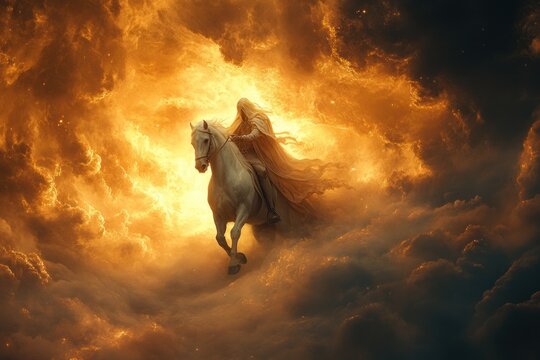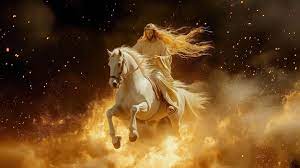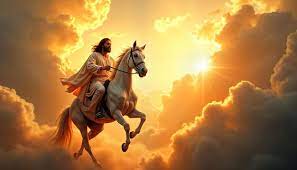A White Horse, Not a Lion
 ✨ The Return of Jesus: A White Horse, Not a Lion
✨ The Return of Jesus: A White Horse, Not a Lion
The book of Revelation paints a vivid and awe-inspiring picture of the return of Jesus Christ. The anticipation of His second coming has inspired countless generations, and the imagery used in the Scriptures offers both comfort and warning. Among the striking symbols presented, the vision of Jesus coming on a white horse stands as one of the most powerful and symbolic moments in the Bible.
While the depiction of Jesus as a lion, especially as a symbol of strength and authority, is well known, it is the white horse that holds the key to His triumphant return. This revelation challenges many preconceived notions and invites us to delve deeper into the significance of these images and what they mean for the world today.
🐴 The White Horse: A Symbol of Victory
In Revelation 19:11-16, we are given a glimpse of the King of Kings returning, riding a majestic white horse:
“I saw heaven standing open and there before me was a white horse, whose rider is called Faithful and True. With justice he judges and wages war. His eyes are like blazing fire, and on his head are many crowns. He has a name written on him that no one knows but he himself.” (Revelation 19:11-12)
The image of Jesus returning on a white horse is far from a mere decorative detail; it is a symbol of victory, purity, and righteousness. In ancient times, a white horse was a sign of triumph, often ridden by generals and kings returning from a victorious battle. The color white, symbolizing purity and holiness, adds another layer to the meaning, signifying that Christ’s victory is not just a military conquest, but a spiritual triumph over sin and death. In this passage, Jesus is not depicted as a humble servant riding a donkey, as He did on His first entry into Jerusalem (John 12:14-15), but as a conqueror, a figure of ultimate authority coming to establish His eternal reign. His return is not to bring peace with the forces of evil, but to judge and bring justice.
In this passage, Jesus is not depicted as a humble servant riding a donkey, as He did on His first entry into Jerusalem (John 12:14-15), but as a conqueror, a figure of ultimate authority coming to establish His eternal reign. His return is not to bring peace with the forces of evil, but to judge and bring justice.
🦁 The Lion of Judah: Strength and Authority
While the white horse symbolizes victory, it is often misunderstood that Jesus’ return would be characterized by Him appearing as a lion. The title of the Lion of Judah is an ancient and powerful image drawn from the lineage of David, representing strength, authority, and kingship. In Revelation 5:5, we are reminded of this powerful symbol:
“Then one of the elders said to me, ‘Do not weep! See, the Lion of the tribe of Judah, the Root of David, has triumphed. He is able to open the scroll and its seven seals.’” (Revelation 5:5)
The lion, a symbol of power and fearlessness, underscores the mighty nature of Christ, who is indeed both the Lion and the Lamb. As the Lamb, Jesus sacrificed Himself for our sins, and as the Lion, He will return as the supreme ruler, with a sword of justice in His hand. Both the Lion and the Horse point to the same truth: Jesus, the King of Kings, will return in ultimate triumph.
However, the depiction of the lion in the book of Revelation doesn’t explicitly show Jesus returning as a lion in the physical sense. Rather, it emphasizes His royal nature and divine authority, which is echoed in the powerful imagery of the white horse.
✨ The Art of Christ’s Return: The Symbolism in Christian Art
The beauty of religious art is that it offers a visual interpretation of the profound truths found in Scripture. Artists through the ages have sought to capture the moment of Christ’s return, often blending various elements of symbolism. The depiction of Jesus riding a white horse has been a popular subject in Christian art, presenting Him as a majestic conqueror, a ruler who is coming to establish God’s kingdom.
While these artworks may not always align with the literal images of the Bible, they capture something deeply spiritual—the promise of Christ’s ultimate victory over all evil. Through artistic representation, believers are reminded of the hope and promise that the world’s brokenness will one day be set right.
Jesus’ return on a white horse is not simply about a dramatic display; it is about the fulfillment of prophecy and the culmination of God’s plan for humanity. Art allows us to experience the visual grandeur of this moment and reflect on its significance.
✨ Conclusion: Riding in Triumph
In the powerful imagery of Revelation, we see that Jesus will return not as a lion in the traditional sense, but on a white horse, a symbol of His triumph over sin and evil. Whether we envision Him as the Lion of Judah, the Lamb of God, or the Rider on the White Horse, the truth remains the same—Christ is coming back to set all things right.
His victory is guaranteed, and His justice will reign forever. This is the hope we cling to, and it is the promise we share with the world. Whether depicted in Scripture or captured in art, the return of Jesus is a glorious truth that invites us to live with hope and purpose, knowing that He will one day restore all things to their rightful place.
Come, Lord Jesus.
